Lights, Camera… Stripers

Spec Fever 1
Stripers are one of my favorite winter fish in North Carolina, so I didn’t mind waking up at 3:30 to leave Wilmington a little before 4:00 am. After a two-hour solo drive (Max, our writer, was out with a broken ankle), a big cup of coffee, and a couple of Bojangles’ biscuits, I found myself pulling into the parking lot of a public boat ramp at Lawson’s Creek Park in New Bern.
The ramp is easy to find, just off of Highway 70 and not far from Highway 17, and Capt. Gary Dubiel, of Spec Fever Guide Service, uses it to meet most of his clients when fishing the New Bern area, mostly because it’s so accessible but also because it’s just a few minutes away from catching stripers.
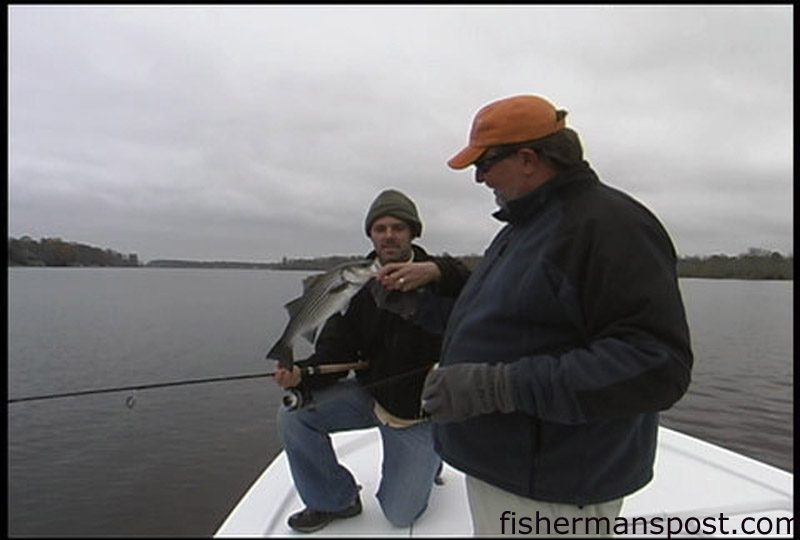
Spec Fever 2
Gary has been charter fishing for over 9 years, and he’s been targeting stripers in the Neuse for over 5 years now. When I met him the day before Thanksgiving, so far in November he had been on the water all but two days. To me, this sounds like the guy I want to go fishing with.
A few days before, Gary easily got me excited for today’s trip by mentioning those three little words everyone I know likes to hear: stripers on topwaters. Then Gary called back the day before and added further excitement to the trip. He was going to make me famous.
We’d be joined on the boat by Capt. Bryan Goodwin, of Native Guide Service out of Beaufort. In addition to guiding, Bryan also hosts a regional TV show called Down East Outdoors. On today’s striper trip, Bryan was going to get back behind the camera for a change. Capt. Gary would be the guest host, and I would be the straight man that asks all the questions.

Capt. Gary Dubiel, of Spec Fever Guide Service, with a New Bern area striper caught just after dawn near Broad Creek on a topwater.
So there we were in the pre-dawn light at a relatively new boat ramp framed in the background of a big Highway 70 Bridge. Bryan wanted a TV show. Gary wanted both himself and the local striper fishery to get media exposure. Me? I wanted several things. I wanted to catch stripers on topwaters. I wanted to see the New Bern and Neuse River diversity (this was my first time fishing this area). I wanted to get to know Gary and Bryan better. Most of all, though, I think I just wanted to not look stupid on camera.
The three of us had only a quick boat ride before our first stop of the day, a stump field on the north side of the Neuse. Gary now fishes a 21.5’ Frontier bay boat, made by K2 Marine, with a 150 Yamaha. His friends at Collins Marine helped set up the relationship with Frontier. The boat was less than three weeks old, and I swear it still had that new boat smell as we came off plane 100 yards from a point in the general vicinity of Broad Creek.
There’s a lot of old timber down along the shoreline, and they create a number of stump fields on both sides of the river. “You’re looking for water a lot shallower than people are generally looking for,” explained Gary, as he quietly lowered the trolling motor and then handed me a rod, “basically about 2-4’ deep with old wood structure in it.”
My job was to ask questions, but I didn’t help my “not look stupid on camera” effort when I asked what tide he liked the best for stripers.
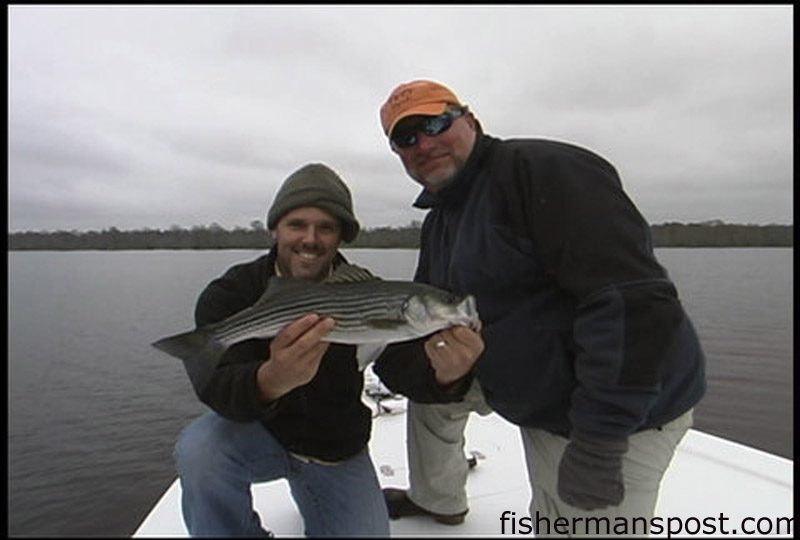
Spec Fever 3
Gary quickly challenged my coastal mind set, “You don’t have a lunar tide. It’s all wind directed, so you’re looking for light and variable winds or winds out of the east—east, northeast, southeast—that holds the water up in those areas and gives you plenty of water to fish those stump fields. The stump fields don’t work when you have wind out of the west. It pulls that water down.”
There had been really heavy rains a few days prior to our trip, so I asked what role the runoff would play in the day’s fishing.
Gary again offered insight into how New Bern fishing is different than the coast. He explained that rain wouldn’t really affect our fishing today because of the direction of the wind over the last few days.
“The harder the wind blows out of the northeast,” he said, “the more the saltwater backs up. As that water’s backing up, the fresh water has a harder time coming in. The opposite is if you get a hard rain and a hard west wind. Then you get fresh water rushing through here real fast, and that will kill your fishing.”
As we pulled close to the stump field, almost immediately we saw baitfish scattering. Gary first spotted (or rather heard) menhaden, but mullet were the most numerous and active. And the stripers that we saw busting on top that morning seemed to be more focused on the small mullet.
“Those are unhappy bait,” Gary noted, pointing to some mullet skipping the surface about 50’ away near the shoreline. The stump field was in between us and the shore, and Gary used the trolling motor to work along the outer line of the mostly submerged stumps.
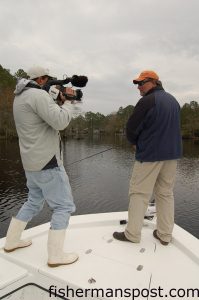
Capt. Bryan Goodwin, of Native Guide Service and the Down East Outdoors TV show, films Capt. Gary Dubiel, of Spec Fever Guide Service, as he talks about soft plastic techniques for stripers in the deeper water of Brice's Creek just off of the Neuse.
The rod that Gary handed me was a new Temple Fork Outfitters 7’ medium action spinning rod with a Penn Conquer 4000 reel spooled with 20 lb. braid. It had a fluorocarbon leader and a topwater tied on the end.
The camera was on, so I stayed in character and asked Gary his opinion of the best topwater baits for this fishery.
“I like MirrOlure Top Dog Juniors and Rapala Skitterwalks,” he said. “Size-wise and rattle-wise, they’re fairly comparable. I like for there to be white in the bait most days. I don’t think the top color necessarily matters, but you most often want a white belly and silver sides or the all white and red head.”
I also asked Gary why he likes braid for topwater fishing, and he explained, “When you get that hit it’s going to come tight. You don’t have to really set the hook. And the heavier baits fish better on the braid. You get less line twist.”
Gary cast into the mullet splashes and his rod quickly bent over with our first striper of the day. I put my topwater in the same spot, but I made the classic rookie mistake and I’m sure it cost me a fish.
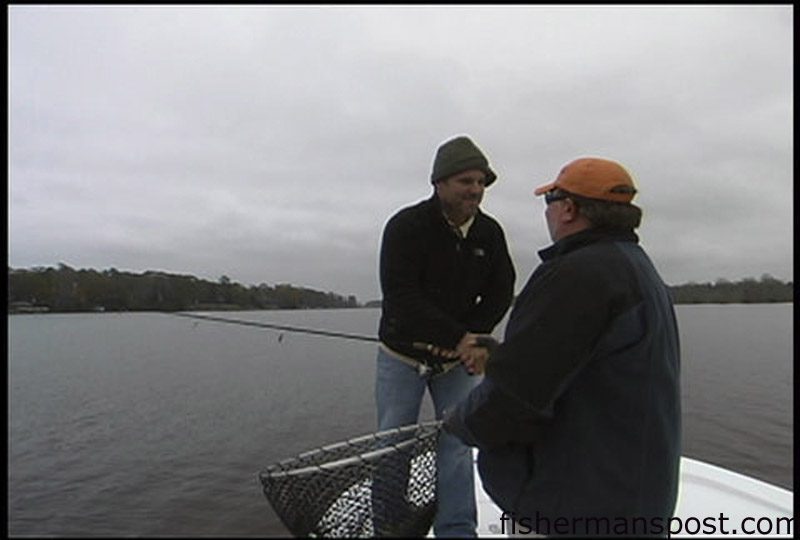
Gary Hurley, of Fisherman's Post Newspaper, gets assistance from Capt. Gary Dubiel, of Spec Fever Guide Service, with handling Gary's first topwater striper of the day. The fish came off a blind cast in the Trent River.
My topwater had also produced some striper attention, generating a significant boil quickly after beginning the “walk the dog” retrieve, but I yanked the topwater too quick and pulled the bait away from the striper before it had committed.
Gary brought his 24” striper to the boat (most stripers, he tells me, in the New Bern area are 20-24”), netted it, pulled it out to give Bryan and the camera a close up, and then quickly released it. Off camera, I had to regroup. For me, topwaters require an inner monologue, a constant reminder to myself not to get excited at a boil in the water’s surface and just keep a steady retrieve.
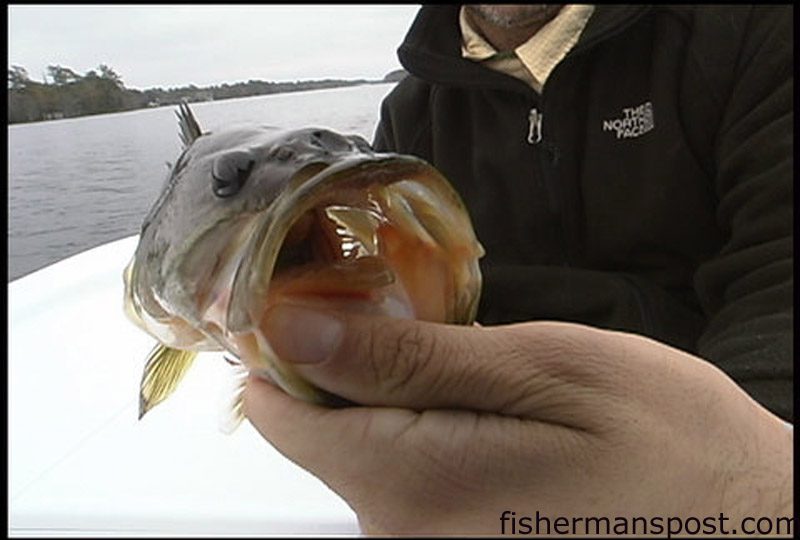
Spec Fever 4
After a few more casts to the location of our first hookup, Gary had me start fan casting the entire area and not get overly focused on one zone.
“The one thing to remember here in the stump field,” he noted, “is that even though you’re fishing wood structure, he’s not a freshwater fish. He’s not sitting in there on that one stump. They move through all of the fallen down timber looking for that baitfish that are out there trying to hide in that structure. You’re looking for feeding activity but also blind casting.”
Gary soon brought another striper to the boat on topwater, but all I could do was raise about 4-5 significant boils. None of my fish at the stump field wanted to commit this morning, and since one of our main goals this morning was to see several different striper environments in the New Bern area, Gary pulled the trolling motor and we headed for the Trent River.
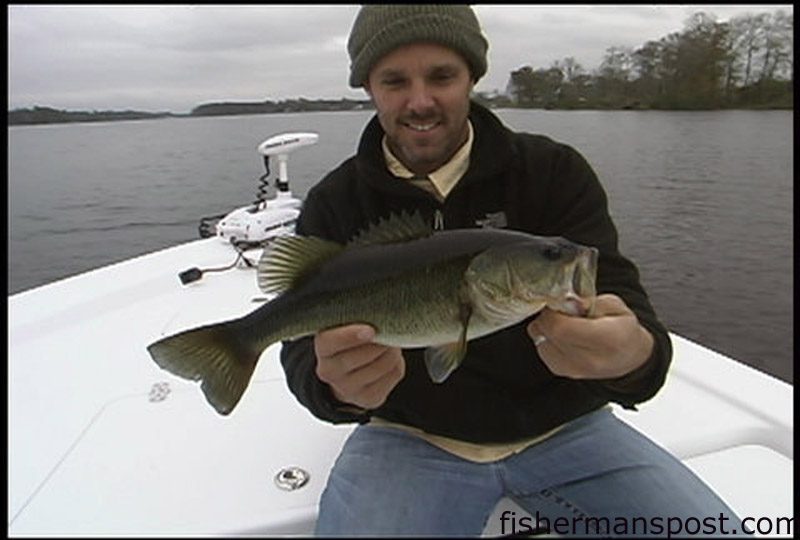
Spec Fever 5
We went well up the Trent River, past Governor Bev Purdue’s and Nicholas Sparks’ houses (Sparks’ is newer and bigger, and we speculated that maybe I should be writing romance novels instead of fishing articles, but I would need to get more in touch with my feminine side) and started fishing a river flat, an area coming off a point where the water along the shoreline stayed at about 3’ deep.
Gary told me that these flats hold a lot of bait and produce well, especially on a cloudy day like today. And like the stump field, these flats are an area where the stripers feed.
“It’s a cloudy condition, low light area best to target in the mornings and late afternoons,” Gary told me as I returned to the front of the boat to resume my work with a topwater. He tossed the topwater for a few casts, but then switched to a soft plastic to more thoroughly search the water.
I, continuing my on-camera role of asking questions, asked him how he makes the call to switch from topwater to soft plastic. In a smooth, television-host voice he replied, “If you feel like there’s fish in the area, the topwater’s just not working, and you’re also not seeing much bait activity in the area, always try to go subsurface. Stripers feed subsurface a lot.”
With soft plastics, he further explains, the fish don’t have to be aggressively feeding to catch them. You fish a soft plastic nice and slow and get it in front of their face. It’s an easy meal, so you can still get them to eat.
On the topwater bite, though, they have to be feeding and aggressive.
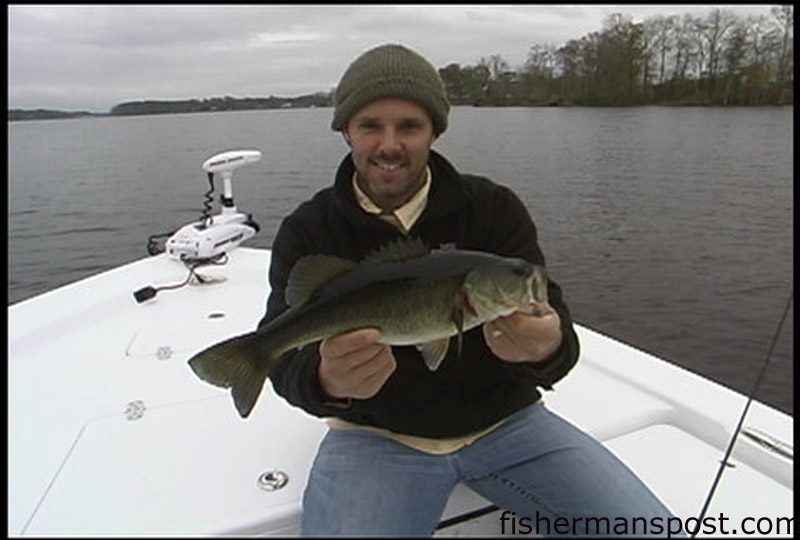
Spec Fever 6
“When they’re not aggressively feeding,” Gary adds, “then you have to find ways to get them to feed, whether it’s fishing soft plastics, fishing Rattletraps slow and covering deeper water, or going with a different hard bait like diving plugs.”
Gary’s a big fan of the soft plastics. He thinks they produce a little bit better and they’re easy to fish. He also makes a good cost effective argument, “If you’re fishing a place with a lot of structure, it’s easier to replace 50 cents worth of soft plastics than $7.50 worth of plug.”
This area didn’t have any stripers working, nor did we even see much bait activity. My instructions were simple—cover as much water with the topwater as possible—and the technique worked. I soon had my first striper on, and it came from a blind cast that landed about 30’ off the shoreline.
The fish had first boiled on my topwater almost immediately after landing, but it hadn’t committed. The striper followed my bait and boiled on it two more times before finally crushing it just 20’ from the boat. My patience was rewarded.
As I started bringing my fish to the boat, my rod bending from numerous strong but short pulls, Bryan told me to slow down and not to catch the fish too fast. For the TV show, he wanted as much tape of the fish as possible. So I had successfully fought my instincts and didn’t yank the topwater too soon, and now I was again asked to fight my instincts by not bringing the fish to the boat too quickly.
The camera continued to roll: net, pose, release, hand shake, recap dialogue, and “Cut!” The scene was a wrap.
As we again worked the area by fan casting topwaters and soft plastics, the gar activity on the water’s surface had me constantly looking at every ripple with anxious enthusiasm. My energy level was high from landing my first New Bern striper, so every boil had me wondering if we were seeing more stripers. Gary gave me a quick lesson in deciphering the good splashes (stripers) from the bad splashes (gar).
“When the gar are coming to the top, they’re sucking air,” he explained. “They have a primitive lung, so they’ll actually come up to the surface and gulp air. You’ll see a gar rolling up in a sipping motion, and there’s not a lot of commotion. The striper’s splash is much more pronounced. You’ll hear that mouth smacking the water, you’ll hear the tail slapping, you’ll see a lot of commotion, and you’ll usually see bait associated.”
While we’re talking, I got an unexpected surprise. I had been working the water around some fallen trees on the shoreline when I think my topwater has found another striper. The fish got close to the boat, but its shape and color seemed a little odd.
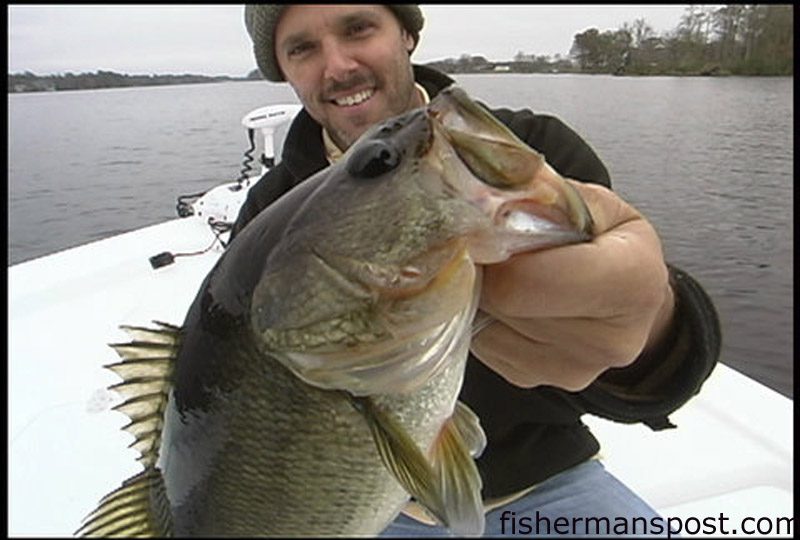
Gary Hurley, of Fisherman's Post, shows off a largemouth bass that was caught on a topwater just a few hundred yards from an earlier striper hookup. He was fishing the brackish waters near New Bern with Capt. Gary Dubiel of Spec Fever Guide Service.
“You’ve got a large mouth bass,” Gary announced as I still wondered why my “striper” was green with yellowish sides.
Since the theme of our day had been diversity, and since I’ve heard about New Bern trips where fresh and saltwater species are caught side by side, I was very pleased with my little bass. And this seemed like a great time for us to head to our third location for yet another New Bern striper fishing haunt.
Our last location of the day was Brice’s Creek, where we were in the day’s deepest water by far (20-22’). For this deep structure area, Gary had us both start by fishing soft plastics, and he handed me a new rod rigged with 8 lb. mono.
“When I jig, I like to free fall the bait to the bottom,” explained Gary, making his first cast out into the middle of our river section. “I think that monofilament falls in the water better. You get a little more resistance with braid, and you don’t get as natural a fall.”
The soft plastics we were working were 4” DOA Cal jerk baits on 1/4 oz. lead heads. The color that we primarily used was the glow halo. It has a holographic, flashy finish to it.
I may have caught a striper and a large mouth bass, but I still knew my role on the boat was to present the host with questions, so I asked Gary what kind of action he wanted me to employ with the soft plastic.
“You want that bait falling,” he told me while demonstrating on his own retrieve, “so you’re going to cast that bait and let it get to the bottom. A good way to indicate you’re on bottom is to keep a relatively tight line on the fall. You’ll see the line stop going, and you’ll know you’re on the bottom. You then want short hops. Pop the bait up, and slowly work that bait back to the boat.”
The key was not to give the bait much speed and remember that you’re fishing for stripers that may be relatively inactive. He reasoned, “You don’t run through the drive thru.”
Gary had an even better analogy for me, “If you put pizza on the table, then someone’s going to eat that pizza because it’s sitting there. If the bait falls in front of their face and it’s an easy, cheap meal, then they’re going to grab it.”
And like it was scripted, at the end of the pizza analogy he set the hook. Gary had successfully produced stripers in three completely different New Bern habitats.
On the way back to the ramp, Gary told Bryan and I that the striper fishing has been picking up over the last few years. They’ve had some success with stocking, they removed a dam so the spawning is a little bit better, they changed some regulations both recreationally and commercially, and it seems to Gary like the striper population is getting better and the fish are getting bigger.
On this trip, we fished both DMF and Wildlife controlled areas, so Gary likes to stress to anyone coming to the area to make sure you have appropriate licensures and follow the appropriate regulations.
One of his favorite resources in the area are the folks at Field and Stream Sports, a local New Bern tackle shop. “They’re going to have a good fishing report, they’ll have what you products you need, and they’ll be able to tell you about the licensing.”
The striper fishing will last at least into February and then start back up again in March, and if the weather stays kind of warm then it goes year round. Gary also fishes the Neuse River out of Oriental and New Bern for redfish and giant drum, speckled trout, flounder, tarpon, spanish mackerel, shad, bass, and catfish, as well as the Crystal Coast for redfish, speckled trout, flounder false albacore, cobia, spanish, amberjacks, and family bottom trips.
If catching stripers on topwaters or soft plastics sounds like a trip you’d like, or if you’d like to book a local guide to teach you how to fish the New Bern striper fishery, then give Capt. Gary a call at (252) 249-1520 or visit him online at www.specfever.com.
